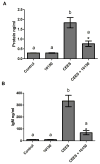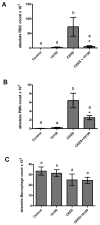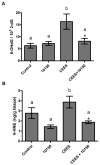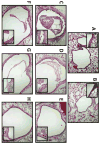Treatment with the catalytic metalloporphyrin AEOL 10150 reduces inflammation and oxidative stress due to inhalation of the sulfur mustard analog 2-chloroethyl ethyl sulfide
- PMID: 20138141
- PMCID: PMC2847650
- DOI: 10.1016/j.freeradbiomed.2010.01.039
Treatment with the catalytic metalloporphyrin AEOL 10150 reduces inflammation and oxidative stress due to inhalation of the sulfur mustard analog 2-chloroethyl ethyl sulfide
Abstract
Sulfur mustard (bis-2-(chloroethyl) sulfide; SM) is a highly reactive vesicating and alkylating chemical warfare agent. A SM analog, 2-chloroethyl ethyl sulfide (CEES), has been utilized to elucidate mechanisms of toxicity and as a screen for therapeutics. Previous studies with SM and CEES have demonstrated a role for oxidative stress as well as decreased injury with antioxidant treatment. We tested whether posttreatment with the metalloporphyrin catalytic antioxidant AEOL 10150 would improve outcome in CEES-induced lung injury. Anesthetized rats inhaled 5% CEES for 15 min via a nose-only inhalation system. At 1 and 9 h after CEES exposure, rats were given AEOL 10150 (5 mg/kg, sc). At 18 h post-CEES exposure BALF lactate dehydrogenase activity, protein, IgM, red blood cells, and neutrophils were elevated but were decreased by AEOL 10150 treatment. Lung myeloperoxidase activity was increased after CEES inhalation and was ameliorated by AEOL 10150. The lung oxidative stress markers 8-OHdG and 4-HNE were elevated after CEES exposure and significantly decreased by AEOL 10150 treatment. These findings demonstrate that CEES inhalation increased lung injury, inflammation, and oxidative stress, and AEOL 10150 was an effective rescue agent. Further investigation utilizing catalytic antioxidants as treatment for SM inhalation injury is warranted.
(c) 2010 Elsevier Inc. All rights reserved.
Figures







Similar articles
-
Improvements in SOD mimic AEOL-10150, a potent broad-spectrum antioxidant.Mil Med Res. 2018 Sep 6;5(1):30. doi: 10.1186/s40779-018-0176-3. Mil Med Res. 2018. PMID: 30185231 Free PMC article. Review.
-
Efficacy of glutathione in ameliorating sulfur mustard analog-induced toxicity in cultured skin epidermal cells and in SKH-1 mouse skin in vivo.J Pharmacol Exp Ther. 2011 Feb;336(2):450-9. doi: 10.1124/jpet.110.173708. Epub 2010 Oct 25. J Pharmacol Exp Ther. 2011. PMID: 20974699 Free PMC article. Review.
-
Catalytic antioxidant AEOL 10150 treatment ameliorates sulfur mustard analog 2-chloroethyl ethyl sulfide-associated cutaneous toxic effects.Free Radic Biol Med. 2014 Jul;72:285-95. doi: 10.1016/j.freeradbiomed.2014.04.022. Epub 2014 May 9. Free Radic Biol Med. 2014. PMID: 24815113 Free PMC article.
-
From the Cover: Catalytic Antioxidant Rescue of Inhaled Sulfur Mustard Toxicity.Toxicol Sci. 2016 Dec;154(2):341-353. doi: 10.1093/toxsci/kfw170. Epub 2016 Sep 7. Toxicol Sci. 2016. PMID: 27605419 Free PMC article.
-
Role of reactive oxygen and nitrogen species in olfactory epithelial injury by the sulfur mustard analogue 2-chloroethyl ethyl sulfide.Am J Respir Cell Mol Biol. 2011 Aug;45(2):323-31. doi: 10.1165/rcmb.2010-0214OC. Epub 2011 Jun 3. Am J Respir Cell Mol Biol. 2011. PMID: 21642592 Free PMC article.
Cited by
-
Improvements in SOD mimic AEOL-10150, a potent broad-spectrum antioxidant.Mil Med Res. 2018 Sep 6;5(1):30. doi: 10.1186/s40779-018-0176-3. Mil Med Res. 2018. PMID: 30185231 Free PMC article. Review.
-
Efficacy of glutathione in ameliorating sulfur mustard analog-induced toxicity in cultured skin epidermal cells and in SKH-1 mouse skin in vivo.J Pharmacol Exp Ther. 2011 Feb;336(2):450-9. doi: 10.1124/jpet.110.173708. Epub 2010 Oct 25. J Pharmacol Exp Ther. 2011. PMID: 20974699 Free PMC article. Review.
-
Sulfur mustard-induced pulmonary injury: therapeutic approaches to mitigating toxicity.Pulm Pharmacol Ther. 2011 Feb;24(1):92-9. doi: 10.1016/j.pupt.2010.09.004. Epub 2010 Sep 17. Pulm Pharmacol Ther. 2011. PMID: 20851203 Free PMC article. Review.
-
Functional and inflammatory alterations in the lung following exposure of rats to nitrogen mustard.Toxicol Appl Pharmacol. 2011 Jan 1;250(1):10-8. doi: 10.1016/j.taap.2010.09.016. Epub 2010 Sep 29. Toxicol Appl Pharmacol. 2011. PMID: 20883710 Free PMC article.
-
Inhibition of NADPH cytochrome P450 reductase by the model sulfur mustard vesicant 2-chloroethyl ethyl sulfide is associated with increased production of reactive oxygen species.Toxicol Appl Pharmacol. 2010 Sep 1;247(2):76-82. doi: 10.1016/j.taap.2010.05.015. Epub 2010 Jun 2. Toxicol Appl Pharmacol. 2010. PMID: 20561902 Free PMC article.
References
-
- Kehe K, Szinicz L. Medical aspects of sulphur mustard poisoning. Toxicology. 2005;214:198–209. - PubMed
-
- Dacre JC, Goldman M. Toxicology and pharmacology of the chemical warfare agent sulfur mustard. Pharmacol Rev. 1996;48:289–326. - PubMed
-
- Papirmeister B, Gross CL, Meier HL, Petrali JP, Johnson JB. Molecular basis for mustard-induced vesication. Fundam Appl Toxicol. 1985;5:S134–149. - PubMed
-
- Elsayed NM, Omaye ST, Klain GJ, Korte DW., Jr Free radical-mediated lung response to the monofunctional sulfur mustard butyl 2-chloroethyl sulfide after subcutaneous injection. Toxicology. 1992;72:153–165. - PubMed
-
- Elsayed NM, Omaye ST. Biochemical changes in mouse lung after subcutaneous injection of the sulfur mustard 2-chloroethyl 4-chlorobutyl sulfide. Toxicology. 2004;199:195–206. - PubMed
MeSH terms
Substances
Grants and funding
LinkOut - more resources
Full Text Sources
Other Literature Sources
Medical
Research Materials
Miscellaneous

